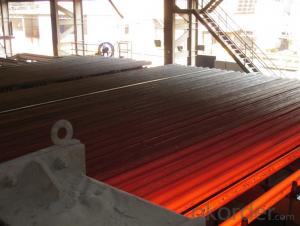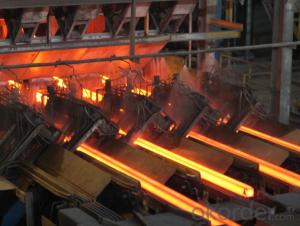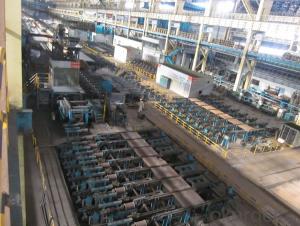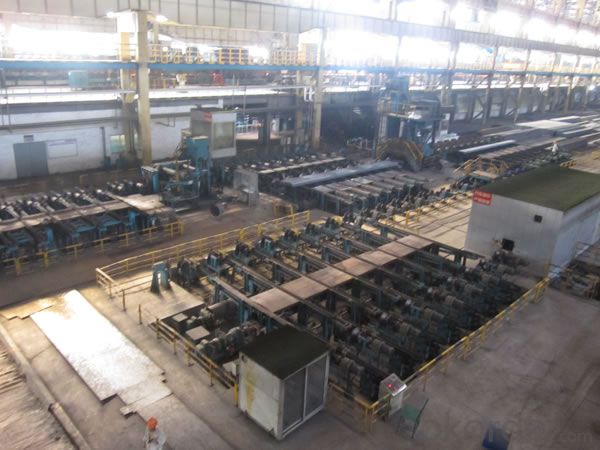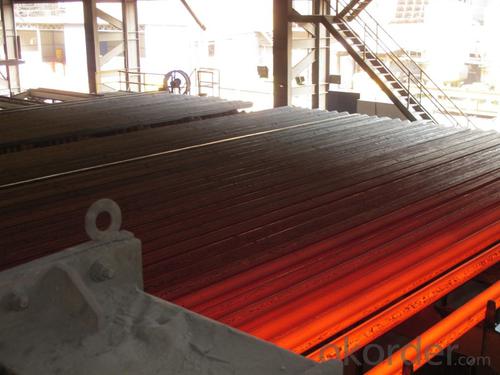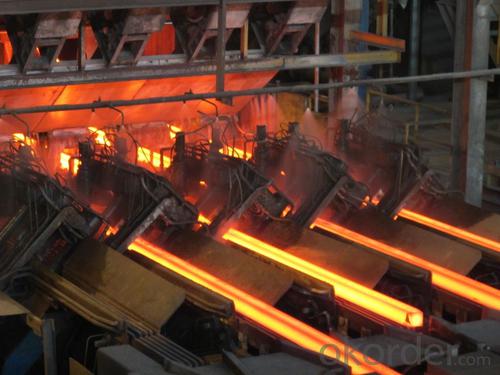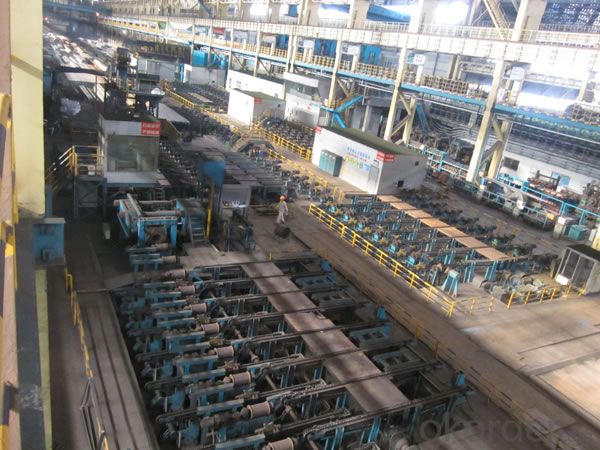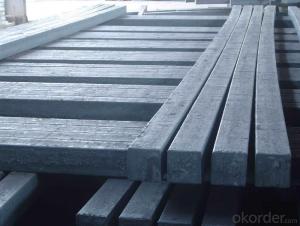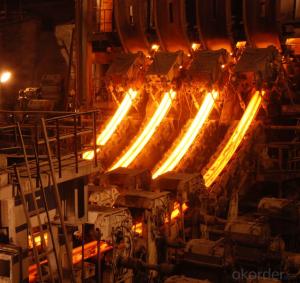Square Steel Billet Q235 3SP Grade Prime Quality 10#
- Loading Port:
- Tianjin
- Payment Terms:
- TT OR LC
- Min Order Qty:
- 2000 m.t
- Supply Capability:
- 50000 m.t/month
OKorder Service Pledge
OKorder Financial Service
You Might Also Like
Description of Square Steel Billet Q235 3SP Grade Prime Quality 10#
M. S. Billets are used for rolling of TMT Re-Bars of Fe415 and Fe500 Grade and various other structural steel products.
CRS Billets are used for rolling of CRS TMT Re-Bars.
Special Alloy Billets are used for rolling of any special grade TMT Re-Bars like Earthquake resistant TMT Re-Bars and for special grade structural steel products.
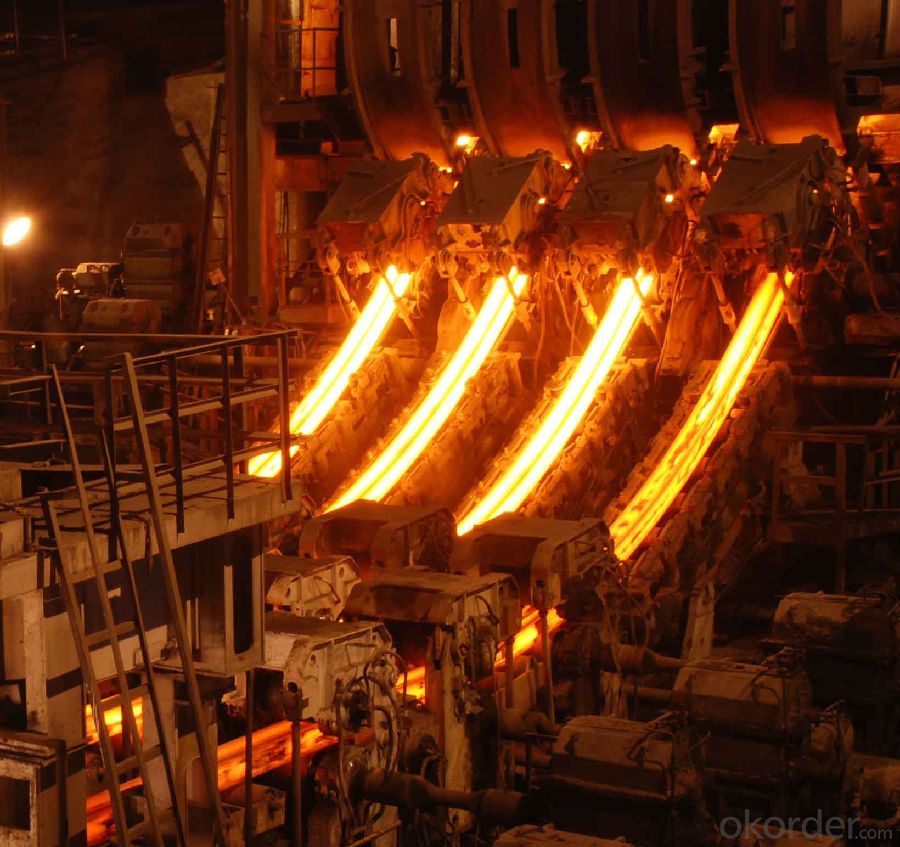
Main Feature Square Steel Billet Q235 3SP Grade Prime Quality 10#
Raw elements(C,Fe,Ni,Mn,Cr,Cu.)---Smelted ingots by AOD finery---hot rolled into black suface---pickling in acid liquid---cold drawn----polished by automatically machine--- cutting into pieces---checking quanlity
Applications of Square Steel Billet Q235 3SP Grade Prime Quality 10#
Widely Used in the areas such as Stainless Steel Fasteners, Chains, Kitchen and Sanitary wares, Furniture handles, Handrails, Electroplating and Electrolyzing pendants, Foods, Electron, Petroleum, Construction and Decoration, etc. Products have a high strength after cold-working. Electronic products parts, Medical appliance, Springs, Bus Inside and Outside packaging and building, Street Lamp Posts, etc. Decoration materials and Outdoor Publicity Billboard. Used for the products which have the Anti-Stress Corrosion requirement. Electron Products, Table-wares, Bolts, Nuts, Screen Meshes, Cumbustors and so on.
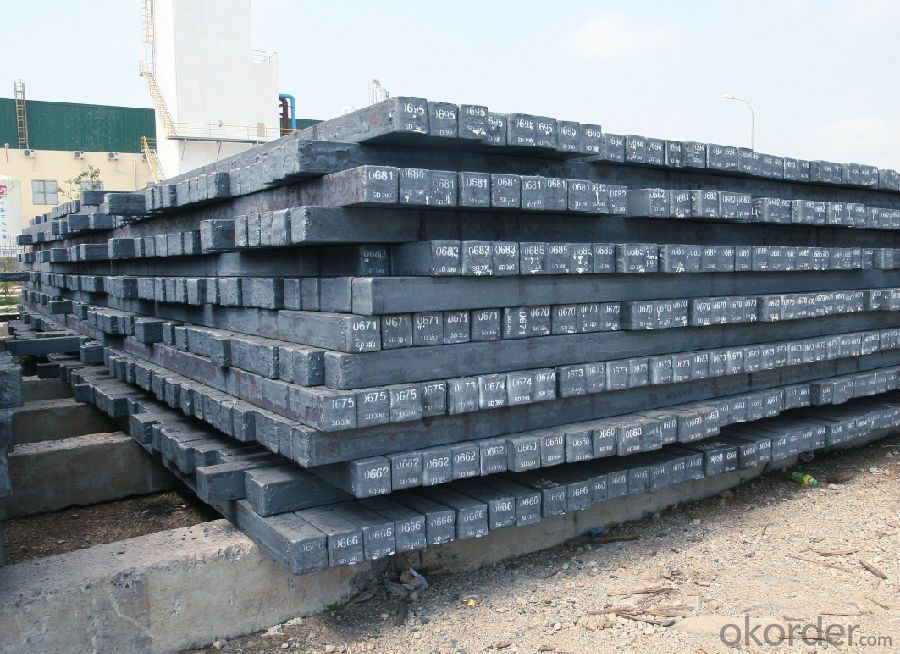
Specifications of Square Steel Billet Q235 3SP Grade Prime Quality 10#
| Standard | C(%) | Mn(%) | S(%) | P(%) | Si(%) |
| Q195 | ≤0.12 | ≤0.50 | ≤0.040 | ≤0.035 | ≤0.30 |
| Q235 | ≤0.20 | ≤1.40 | ≤0.045 | ≤0.045 | ≤0.35 |
| Q275 | ≤0.22 | ≤1.50 | ≤0.045 | ≤0.045 | ≤0.35 |
| 20MnSi | 0.17-0.25 | 1.2-1.6 | ≤ 0.050 | ≤ 0.050 | 0.40-0.80 |
| 3SP | 0.14-0.22 | 0.40-0.85 | ≤ 0.050 | ≤ 0.040 | 0.05-0.15 |
| 5SP | 0.28-0.37 | 0.50-1.00 | ≤ 0.050 | ≤ 0.040 | 0.15-0.30 |
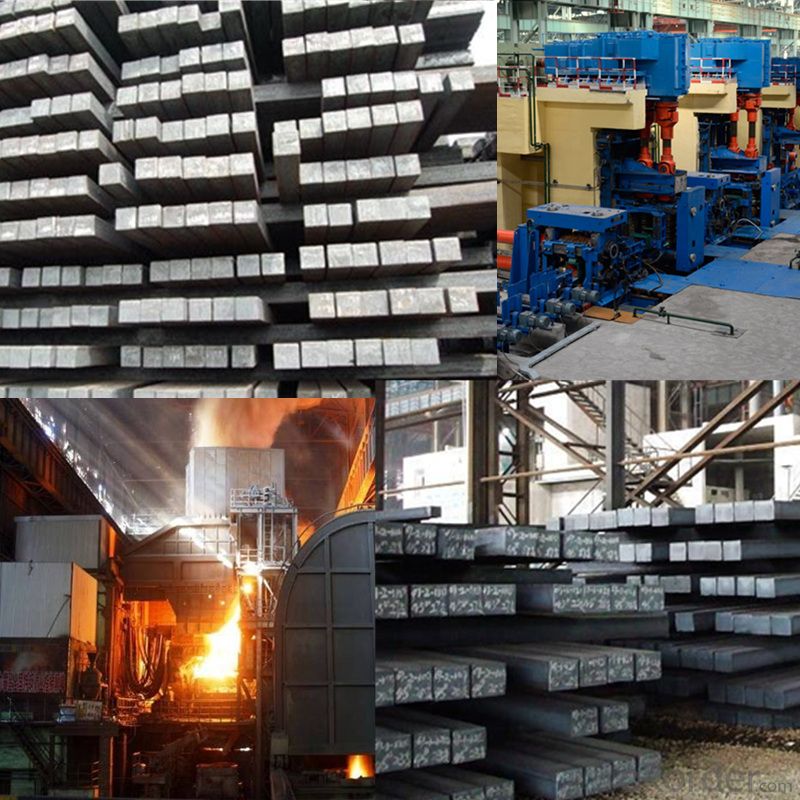
FAQ of Square Steel Billet Q235 3SP Grade Prime Quality 10#
We have organized several common questions for our clients,may help you sincerely:
1. How Can I Visit There?
Our company is located in Tianjin City, China, near Beijing. You can fly to Tianjin Airport Directly. All our clients, from home or aboard, are warmly welcome to visit us!
2. How Can I Get Some Sample?
We are honored to offer you sample.
3. Why choose CNBM?
Our delivery time about 15-20days for standard sizes, if you have other requirements like hardness, quanity and width ,it is about 20-40days. But don't worry we also try our best for the delivery time ,because time longer and our cost is higher.
- Q: What are the different forging methods used for steel billets?
- Steel billets can be forged using different methods, each with its own advantages and applications. Open Die Forging is a method where the steel billet is shaped between flat dies. This allows for flexibility in design and size, making it suitable for larger and more complex parts that require customization, like shafts, cylinders, and discs. Closed Die Forging, also known as impression die forging, involves shaping the steel billet within a set of dies that contain the desired shape. It is ideal for producing high-precision and complex parts with tight tolerances, such as gears, connecting rods, and crankshafts. Upset Forging is a method that involves increasing the cross-sectional area of the steel billet by compressing it between dies. This is commonly used for creating short-length parts like bolts, screws, and fasteners. Roll Forging uses cylindrical rolls to gradually shape the steel billet into the desired form. It is often used to produce long parts with a consistent cross-section, such as bars, rods, and shafts. Press Forging utilizes a hydraulic or mechanical press to shape the steel billet, providing greater control over the forging process. This method is often employed for manufacturing automotive components, aerospace parts, and tools. Isothermal Forging involves heating the steel billet and the dies to the same temperature, reducing the cooling effect during forging. This allows for greater control over the microstructure and mechanical properties of the final product, making it suitable for producing parts that require high strength and temperature resistance. Each forging method has its own benefits, allowing steel billets to be shaped into a wide range of products with varying complexity, size, and mechanical properties. The choice of forging method depends on factors such as the desired product, material properties, production volume, and cost considerations.
- Q: What are the main factors that determine the pricing strategy of steel billets manufacturers?
- The pricing strategy of steel billets manufacturers is influenced by several key factors. These factors play a crucial role in determining the pricing decisions made by manufacturers in the steel billets industry. 1. Raw Material Costs: The cost of raw materials, particularly iron ore and scrap metal, is a significant factor in determining the pricing strategy. Fluctuations in the cost of these materials can directly impact the overall production costs and, subsequently, the pricing of steel billets. 2. Production Capacity: The production capacity of a steel billets manufacturer influences the pricing strategy. Manufacturers with higher production capacity may be able to achieve economies of scale, resulting in lower production costs and potentially more competitive pricing. 3. Market Demand: The level of demand for steel billets in the market is an essential factor in pricing decisions. Higher demand often allows manufacturers to set higher prices, while lower demand may necessitate more competitive pricing strategies to attract customers. 4. Competition: The level of competition within the steel billets industry also plays a significant role in determining pricing strategies. Manufacturers must consider the pricing strategies of their competitors to ensure they remain competitive in the market. Factors such as market share, product differentiation, and branding can influence a manufacturer's ability to set prices. 5. Transportation and Logistics Costs: The cost of transporting raw materials and finished products can impact pricing decisions. Manufacturers located closer to raw material sources or major markets may have a cost advantage over those located further away. Transportation costs, including fuel prices, shipping fees, and infrastructure quality, can influence the final pricing strategy. 6. Government Regulations: Government regulations, such as import/export duties, taxes, and tariffs, can affect the pricing strategy of steel billets manufacturers. These regulations may impact the cost of raw materials or the ability to access certain markets, ultimately influencing pricing decisions. 7. Economic Factors: General economic conditions, including inflation rates, interest rates, and exchange rates, can impact the pricing strategy. Manufacturers need to consider these factors to ensure their prices remain competitive and reflect changes in the overall economic climate. Overall, the pricing strategy of steel billets manufacturers is a complex interplay of various factors, including raw material costs, production capacity, market demand, competition, transportation costs, government regulations, and economic factors. Manufacturers must carefully analyze these factors to determine a pricing strategy that maximizes profitability while remaining competitive in the market.
- Q: What is the role of steel billets in the construction of stadiums and arenas?
- Steel billets play a crucial role in the construction of stadiums and arenas as they are the primary raw material used to manufacture structural steel components. These billets are heated and shaped into various forms, such as beams, columns, and trusses, which provide the necessary support and framework for the overall structure. The high strength and durability of steel make it an ideal material to withstand the heavy loads and forces experienced in these large-scale facilities. Additionally, steel billets can be easily fabricated and assembled on-site, ensuring efficient construction and enabling the creation of complex designs and architectural features.
- Q: How are steel billets used in the manufacturing of railway equipment?
- Steel billets are used in the manufacturing of railway equipment as they are heated and then shaped into various components such as rails, wheels, axles, and couplings. These billets serve as the raw material that undergoes further processing, including cutting, bending, and welding, to create the final products used in the construction and maintenance of railway systems.
- Q: How are steel billets used in the manufacturing of shafts?
- Steel billets are an integral component in the manufacturing of shafts. Billets are essentially semi-finished steel products that are typically square or rectangular in shape. They are produced through a process called casting, where molten steel is poured into molds and allowed to solidify. In the context of shaft manufacturing, steel billets serve as the starting material. They are heated to a specific temperature to make them more malleable and easier to work with. Once heated, the billets are then subjected to a series of processes such as forging, rolling, or extrusion. Forging involves shaping the heated billet by applying compressive forces using a hammer or a press. This process helps refine the grain structure of the steel, improving its strength and reducing any internal defects. Rolling, on the other hand, involves passing the billet through a series of rollers to gradually shape it into the desired form. It is commonly used for producing long, cylindrical shafts. Extrusion is another technique used in the manufacturing of shafts. In this process, the heated billet is forced through a die using high pressure, resulting in a shaft with a specific cross-sectional shape. This method is particularly useful for producing shafts with complex geometries or intricate details. After the initial shaping process, the shafts are further machined, heat-treated, and finished to achieve the desired dimensions, surface finish, and mechanical properties. Machining involves removing excess material and creating specific features such as keyways or threads. Heat treatment is used to enhance the shaft's strength, hardness, and durability. In summary, steel billets are the raw material in the manufacturing process of shafts. Through various shaping techniques such as forging, rolling, or extrusion, the billets are transformed into the desired shape, size, and properties of the shafts. This ensures that the resulting shafts are strong, reliable, and suitable for their intended applications in industries such as automotive, aerospace, and machinery.
- Q: What are the different heat treatment processes for alloy steel billets?
- There are several different heat treatment processes for alloy steel billets, including annealing, normalizing, quenching, and tempering. Annealing involves heating the billets to a high temperature and then slowly cooling them to relieve internal stresses and improve ductility. Normalizing is similar to annealing but involves air cooling instead of slow cooling. Quenching involves rapidly cooling the billets in a liquid medium, such as oil or water, to increase hardness and strength. Tempering is done after quenching and involves reheating the billets to a specific temperature and then cooling them slowly to reduce brittleness and improve toughness.
- Q: Billet heating furnace prices?
- Look at the video case, you can consult the advisory.
- Q: What are the main factors affecting the surface quality of steel billets?
- The surface quality of steel billets is influenced by several factors. Firstly, the cleanliness of the steel plays a crucial role. Contaminants such as oxides, scale, and inclusions can negatively impact the surface quality. These impurities can cause defects like pits, cracks, and roughness on the surface. Secondly, the temperature during the steelmaking process is an important factor. If the steel is overheated, it can lead to excessive scaling and oxidation, resulting in a poor surface finish. On the other hand, if the steel is not heated adequately, it may have a non-uniform surface and inconsistent mechanical properties. Additionally, the presence of residual stresses can affect the surface quality. Uneven cooling or improper heat treatment can cause residual stresses, leading to surface cracks, warping, or distortion. The type and effectiveness of the surface treatment or finishing processes also impact the surface quality of steel billets. Processes like grinding, polishing, or shot blasting can improve the surface finish by removing defects and creating a smoother surface. Moreover, the quality of the equipment and tools used in steel production plays a significant role. Worn-out or poorly maintained machinery can result in surface defects, inadequate surface preparation, or improper handling, affecting the final surface quality. Lastly, the composition and microstructure of the steel itself influence the surface quality. Variations in alloying elements, grain size, and phase distribution can affect the surface finish, hardness, and overall quality of the billets. In conclusion, the main factors affecting the surface quality of steel billets include cleanliness, temperature control, residual stresses, surface treatment processes, equipment quality, and the composition of the steel. Addressing these factors through proper steelmaking practices, surface treatments, and quality control measures is crucial for achieving high-quality steel billets with superior surface finish.
- Q: How do steel billets come out?
- I. mining1, iron ore2 limestone mine3, coal mineTwo 、 burden preparation1. Iron ore sintering2 coking coal cokingThree, iron: in the blast furnace, sintering iron ore, limestone, coke, iron ore in the iron elements reduced to metal iron, then the product is pig iron.
- Q: How are steel billets used in the production of mining equipment?
- Due to their strength, durability, and versatility, steel billets are crucial for the production of mining equipment. These billets are typically made by pouring molten steel into a mold, resulting in a solid rectangular shape. They are then used as raw material in the manufacturing process of mining equipment. Mining operations require robust and reliable components for equipment such as excavators, bulldozers, and crushers, to withstand harsh conditions and heavy loads. Steel billets provide the necessary structural integrity and toughness, ensuring efficient and safe equipment operation. Once obtained, steel billets undergo various techniques such as forging, machining, and welding to transform them into specific parts and components. Forging can create heavy-duty gears, shafts, and axles, which are essential for mining equipment. Machining steel billets allows for custom-made components that fit seamlessly into mining equipment. This process involves cutting, drilling, and milling to create parts like buckets, cutting edges, and chassis. In addition, welding steel billets together creates complex structures and ensures equipment integrity and strength. This is particularly important in mining equipment construction, where safety and reliability are paramount. In conclusion, steel billets are vital for producing mining equipment as they provide the necessary raw material. Their strength, durability, and versatility allow for the creation of robust and reliable components that can withstand the demanding conditions of mining operations.
Send your message to us
Square Steel Billet Q235 3SP Grade Prime Quality 10#
- Loading Port:
- Tianjin
- Payment Terms:
- TT OR LC
- Min Order Qty:
- 2000 m.t
- Supply Capability:
- 50000 m.t/month
OKorder Service Pledge
OKorder Financial Service
Similar products
Hot products
Hot Searches
Related keywords

